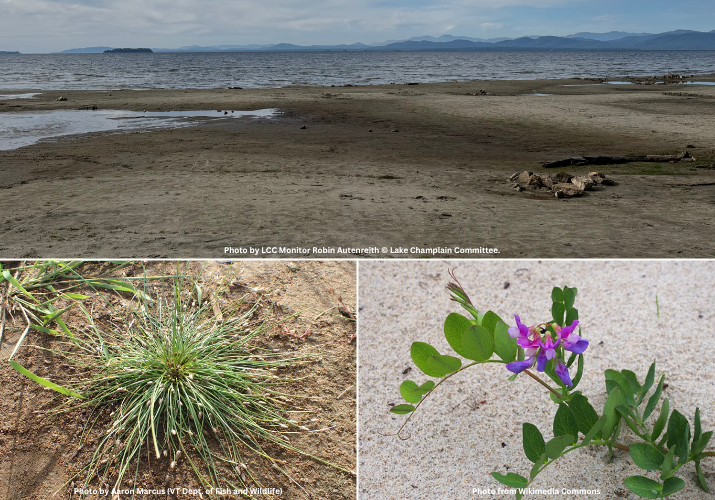Nature Note - Low Lake Levels and Shoreline Habitat
After the summer floods of 2023 and 2024, many in the Lake Champlain basin watched nervously for a third deluge this past summer. Instead, we got the opposite extreme: a drought, which brought lake levels to near record lows and exposed previously submersed rocks and beaches. Low lake levels have many implications, including a loss of shallow water habitat and new navigational hazards for boaters. Turning away from the water and toward the beach, those exploring the basin may have encountered an unexpected ecological consequence of the drought on shore as well.
Grace Glynn, a botanist with the Vermont Department of Fish and Wildlife, has noticed some unusual plant activity this summer on the shoreline. Lake Champlain is home to a notable habitat type: the drawdown shore, which is normally submersed underwater in springtime when lake levels are naturally higher, and exposed in autumn, as lake levels recede. Botanists find these shifting beaches interesting because, unlike most landscapes in our region, they do not tend to turn into forests over time. Drawdown shores are subject to too many natural disturbances—such as ice scour, wind, and fluctuating water levels—for most trees to establish, so plants uniquely adapted to this disturbance regime can be found here and nowhere else.

Plants found on the drawdown shore, including beach pea, Champlain dunegrass, and the globally rare Wrights spikebrush, tend to suffer in floods and thrive in dry conditions. Lower lake levels open up more habitat for them, and they have evolved to take dry years as opportunities. For annual plants like these species, the ability to flower and get to seed is key, as their seeds can remain dormant for years while they wait for the next dry season. One might expect that this summer’s drought would be good news for these shoreline plants.
Grace, however, has noticed the opposite. "I've found that on many Lake Champlain beaches, this year has been too dry even for these drawdown plants," she said. "At Alburgh Dunes State Park—the largest example of Lake Sand Beach in Vermont—the seepage waters that typically flow onto the beach from the upland swamp have dried up. The low swales on the sand beach, typically consistently wet in the summer, are desert-dry, and the drawdown plants are relatively scarce. Interestingly, I noted that many of the annual drawdown sedges germinated during the summer and were promptly buried by sand blowing up from the expanse of dry beach." In essence, this summer has been too dry even for the plants that thrive in dry conditions—upland water sources are depleted, and the parched sand is burying the plants before they get to seed.
It's hard to say what this means for the long-term viability of these special habitats on Lake Champlain. Sandy beaches are inherently dynamic, with the dramatic seasonal variability they already face. Plants adapted to these habitats are ready for a certain level of unpredictability. Being an annual plant helps: as seeds, they can wait out years of inopportune conditions before germinating. But climate change’s extremes create unprecedented volatility. Grace emphasized that we’re learning as we go: “This is all new, and we're still figuring out the implications. This year reinforced the importance of boots-on-the-ground observations. We can't assume to know [how droughts and floods] will impact these habitats in the long-term, so collecting real-time data is key.” Drawdown plants, and the thousands of seeds lying dormant among Lake Champlain’s sandy beaches, offer lessons in resilience, patience, and adaptability – but only time will tell whether they endure the extreme challenges they now face.
